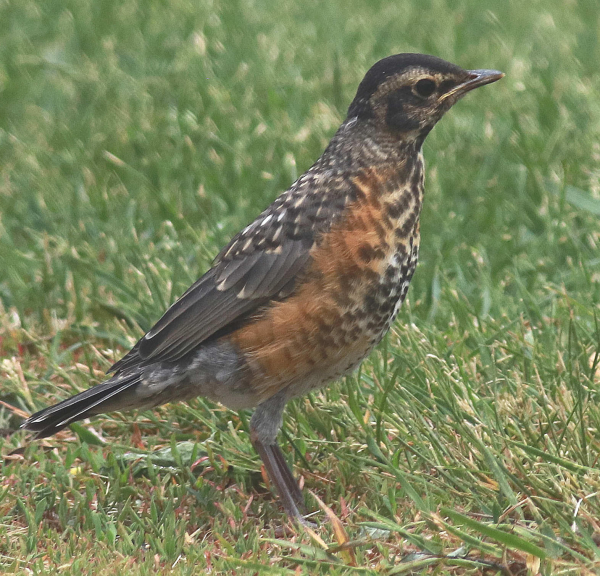
Fledgling American Robins can be distinguished by their spotted plumage, which can vary somewhat from individual to individual. This year’s hatch of robins and other birds will continue to share our yards and neighborhoods throughout the summer.

A food-begging fledgling Northern Mockingbird is being fed, and protected, by the adults. However, the female may begin laying a second clutch, leaving the male to care for fledglings from their first nesting attempt.
|
Many bird nests and nesting activities are obvious, but some birds can be surprisingly secretive about the location of their nest, and hide their approaches to and from the nest site to avoid detection. Even experienced birders can be surprised that an undetected nest is only revealed after a fledgling appears in your yard. Although the first fledglings began appearing many months ago in the Sunbelt, it’s been six weeks or so since the first fledglings left their nest in more northern areas.
Earlier fledglings are now self-sufficient and resemble adults in most ways, except plumage in some species. Even so, a few fledglings continue to appear as species after species completes nesting activities – and as some species re-nest.
Re-nesting
A few birds nest more than once during a single nesting season. Northern Mockingbirds, American Robins, the three species of bluebirds, House Wrens, Cactus Wrens, Northern Cardinals, Gray Catbirds, Barn Swallows, Purple Martins, Hooded Orioles, Red-headed Woodpeckers, Song Sparrows, Dark-eyed Juncos, Red-winged Blackbirds, Common Grackles, and Western Meadowlarks are examples of birds that may nest more than once per year. A few common hummingbird species also nest twice, including Ruby-throated, Anna’s, Allen’s, Broad-tailed, and Black-chinned Hummingbirds.
Pairs of some species may even nest three times, such as Eastern Bluebirds, Northern Mockingbirds, Carolina Wrens, Northern Cardinals, Anna’s Hummingbirds, and Ruby-throated Hummingbirds, although these three nesting attempts in one season must be considered somewhat exceptional. Mourning Doves, however, are the most prolific nesters, and pairs have been documented nesting up to six times per season, although two or three nesting attempts per year is more normal.
Some species are more likely to re-nest in the southern part of their range than in the north. For example, Blue Jays, Horned Larks, and Least Flycatchers nest once in the northern part of their nesting range, but some pairs may nest twice in the south where the weather is more suitable for a prolonged nesting season.
Post-Fledging
Young birds are actually the most vulnerable after leaving the nest than any other time in their life. After young birds leave the nest – during the post-fledging period – new fledglings continue to be cared for and fed by one or both adults. Fledglings learn, or instinctively know, what to eat, where to find food, and what constitutes danger, and they do all this while learning to fly!
This “fledgling–adult learning period” is paramount to the survival of young birds, and it may continue for weeks. Although fledglings are not very able to fly for a day or two after leaving the nest, they learn quickly, many species fly quite well in a day or two. In the meantime, fledglings will follow a parent to beg for food and learn how and where to find food in the process. In a short time, the fledgling will take the lead, and the adult will follow, keeping a watchful lookout and foraging on its own.
Any time you see a young bird during the nesting season, please do not to disturb it. One or both of adult pair are nearby and will soon bring food to the fledglings. Have faith that birds will prosper on their own and let nature act and react normally without human intervention.
Enjoy observing young fledglings during the post-fledging period, which is an especially interesting time in our birding year. If you are lucky, you will see a variety of nesting birds continue to protect, feed, and teach their fledglings all around you for some weeks to come. Then too, it’s fun seeing young birds like robins, cardinals, chickadees, and others in your yard as they mature. When new fledglings show up to utilize the backyard habitats we provide, it’s one of the ultimate rewards of backyard birding endeavors. Enjoy this exciting season.
Share your birding experiences and photos at editorstbw2@gmail.com